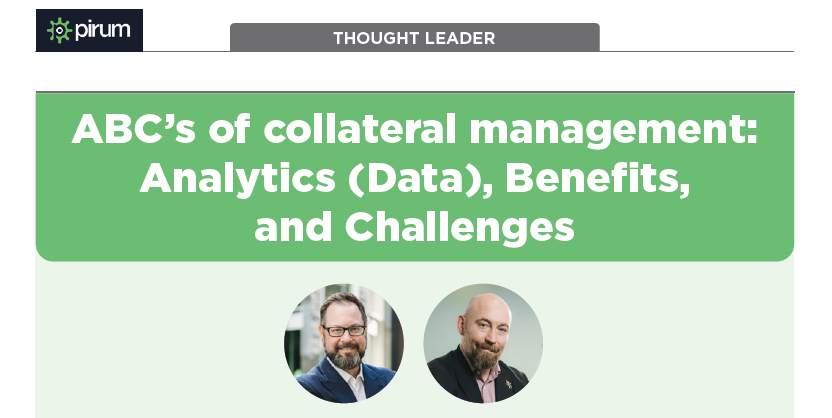Pirum: ABC’s of collateral management
9th October, 2023|Global Investor

Pirum's Todd Crowther and Scott Brown recently discussed collateral management intricacies. They explored challenges and benefits, highlighting the significance of data analytics and emerging technologies in optimizing this practice.
ABC’s of collateral management:Analytics (Data), Benefits,and Challenges
Global Investor spoke with Pirum’s head of corporate development and collateral services, Todd Crowther and the head of origination sales - EMEA, Scott Brown on collateral management challenges, benefits, and the role of data analytics and emerging technologies in optimizing it.
This article is part of the 2023 Collateral Guide, which can be accessed here.
Optimization Opportunity
Looking at current industry challenges, collateral optimization presents a major opportunity for firms to improve profitability and performance, decrease pressure on finite financial resources like capital, reduce specific and systemic risk as well as improve adherence to an evolving regulatory landscape.
Many firms within the securities finance industry are already harnessing ways to drive collateral optimization which goes some way to achieving these objectives. With that being said, the industry challenges rather than abating, appear to be growing.
A rising rate environment and heightened market volatility events (see the LDI crisis), for example, have resulted in further pressure on firms’ profitability and financial resources. In addition, new and evolving regulatory initiatives have added additional layers of complexity for firms to remain compliant and operationally efficient.
These evolving initiatives include increased mandated central clearing, expansion of mandatory uncleared OTC margining, implementation of shorter settlement cycles and the adoption of new standardised risk approaches such as the new BASEL IV IRB and TWD regimes.
Collateral Challenges
The impacts of a heightened regulatory and markets environment means that the cost of doing business for participants has materially increased. The cost of doing business for collateral management includes the need to automate the posting of more margin to more participants, across more products and an expanding set of locations. In addition, this must be done in the most efficient way possible in order to minimise the use of excess capital and its associated costs.
Given that secured financing and collateralised trading activities represents the largest non-FTE cost to support secondary markets activity, firms are now viewing efficient collateral management and optimization as mission critical to not only address these rising costs but as an opportunity to drive substantial savings.
These savings can be achieved by minimising liquidity costs, reducing funding costs and maximising capital efficiencies in a drive to improve returns. Enhanced efficiencies also enable firms to better support their businesses by reducing risk, improving service capabilities and enabling future growth.
Pirum believes that through the effective implementation of advanced technology to support better target operating models, firms can address both these challenges and achieve these benefits.
Implementation Options
When considering the benefits to be achieved, how should firms consider the cost to adopt best practice collateral management and how should they consider the alternatives between a build versus buy approach?
Firms are seeking to reengineer their enterprise and transform platforms to address a series of collateral challenges and requirements. Firms aim is to streamline collateral management processes to break down internal silos in order to address operational risk, add scalability and improve decision-making processes to better manage finite resources on an enterprise level.
The decision to build or buy boils down to a number of factors which, Crowther states, is ultimately a decision firms make based on four main factors including return, cost, timeframe, and implementation risk. In addition, firms need to also consider the future landscape based on the emergence of new technology such as artificial intelligence and blockchain.
Firms will wish to be forward compatible or leverage these new technologies as they seek to better digitise workflows, streamline data and enable more realtime collateral management.
ROI Upside
From a top line perspective, it has been estimated by various consultancies such as EY and PWC that firms benefit from an upside of 10x-15x the return on investment where payback is achieved typically within the first year on ~40% of projects. Additional benefits include improved regulatory compliance in order to better meet both current and future regulatory requirements such as BCBS 248 & Regulation YY.
Many firms who are now optimizing their collateral management processes indicate that it brings an increased competitiveness in the marketplace, which in turn enables these firms to better service their clients. Finally, the adoption of new collateral management technology also provides the opportunity to improve a firm’s riskreturn profile by not only increasing top line revenue but also by reducing operational, credit, market, liquidity and funding risks.
Cost to Implement
From a cost implementation perspective, firms need to be aware of potential complexities of implementing an enterprise-level solution which has the potential to centralise activities for a firm but often requires strategic investment and transformational change.
Taking into account the cost of connectivity, firms need to consider the cost of opening and keeping the lines open, with a particular focus on wide diversification of collateral venues such as triparty, bilateral and CCPs. Furthermore, given the mandated shortening of settlement timeframes, especially with the US SEC migration to T+1 set for next year, firms need to establish this connectivity on an intraday basis in order to better support accurate and timely processing of margin and collateral activities. Finally, looking at the data side, firms need to think about digitisation, real-time data management and the ondemand intelligence required to support optimization for complex objectives like LCR, NSFR and RWA.
To this end firms require flexible implementations, and with this in mind, Pirum has collaborated with J.P. Morgan and Euroclear as a ‘connectivity agent’ to offer STP directed allocation capabilities for firms that choose to use an in-house (or third-party licensed) optimizer, or alternatively, Pirum and BNY Mellon has formed a strategic collaboration to offer firms a more comprehensive, managed service option by supporting an ‘outsourced algo’ solution via BNYM’s ECPO service.
The ECPOConnect service integrates two production-ready platforms that complement each other whilst enabling each company to more capably solve a key client ask: deliver a turnkey, end-to-end portfolio optimization solution for their enterprise.
Time-to-Market
Looking at the ongoing costs of adopting such enhanced collateral management processes, firms need to consider the burden of integration, maintenance, and the need for continuous investment into technology. With so much connectivity and data to integrate, it is important for firms to consider readily available solutions, even if plugging into an existing network, given the fact there are multiple triparty agents, over 60 CCPs and Exchanges as well as 100s to 1000s of bilateral counterparts.
Additionally, firms need to be aware of the hidden cost of maintaining status quo, the continuous investment required to ‘standstill’ as the complexity of the business landscape changes as well as the industry adopts new emergent technologies such as DLT, AI and machine learning.
Risk of Delivery
From an implementation perspective, the ability of firms to create transformational change can boil down to an assessment of the risk of adoption. An internal build may look more attractive from a cost perspective however existing, proven technologies offered by vendors and infrastructure providers can be less risky (and costly) to implement. Where firms aim to deliver highly configurable, resilient and scalable solutions, they should consider options with an established track record of delivering and supporting enterprise-level requirements.
Extensibility should also be a consideration as a means to expand across product silos, geographic locations and different business lines. Looking at the ability to scale, firms also need to assess the ability to solve big data problems, which can be done through collaboration with the right partners to reduce execution risk and enable the solution to scale quickly to achieve faster time to market. Just like learning your ABC’s, we hope to have made this complex topic easier to understand.


